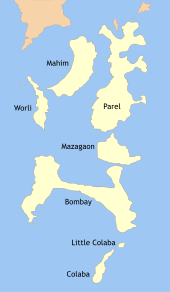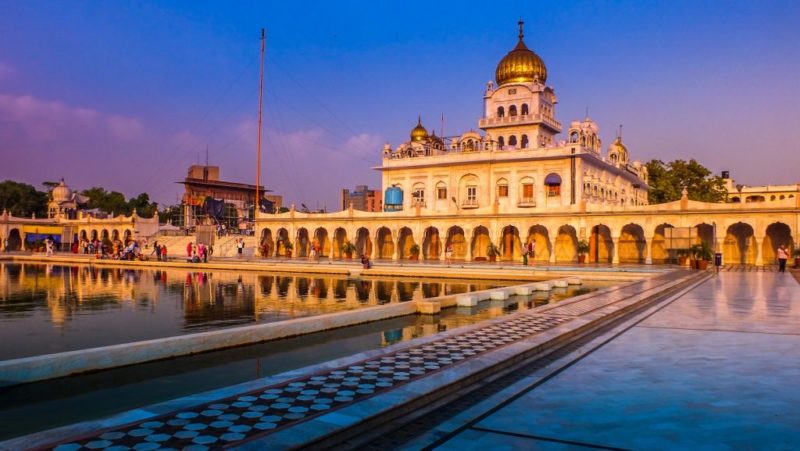Колаба (англ. Colaba) — остров в Индийском океане, ранее входивший в состав архипелага Семь островов Бомбея и расположенный на территории Индии. Во время португальского правления в XVI веке остров был известен как Кандил. После того, как британцы захватили остров в конце XVII века, он был известен как Колио.
Источник: https://wiki2.org/ru/%D0%9A%D0%BE%D0%BB%D0%B0%D0%B1%D0%B0
Содержание
История

Название Колаба происходит от Kolabhat, слова на языке колис, коренных жителей островов, до прибытия португальцев. Территория, которая теперь является Колабой, первоначально состояла из двух островов: Колаба и Малая Колаба (или Остров Старухи). Остров Колаба был одним из семи островов Бомбея, управляемых португальцами.
Португальцы приобрели эти земли у султаната Камбея по Басейскому договору (1534). Группа островов была отдана Португалией Карлу II в качестве приданого, когда он женился на Екатерине из Браганцы в 1661 году. Передача Бомбея и соседних территорий была негативно воспринята португальскими чиновниками в Гоа и Бомбее, которые несколько лет сопротивлялись передаче владений. Возмущенный задержкой, Карл II сдал эти земли в аренду британской Ост-Индской компании за номинальную годовую арендную плату. Джеральд Онье, второй губернатор Бомбея (1672 г.) и президент английского поселения Сурат, вступил во владение Колабой и островом Старухи от имени Компании в 1675 году. Португалия продолжала удерживать остров Малая Колаба ещё несколько десятилетий, прежде чем передала его англичанам примерно в 1762 году, при условии сохранения в португальском владении дома на острове.
В 1743 году британская Колаба была сдана в аренду Ричарду Бротону за 200 тысяч в год, и аренда была возобновлена в 1764 году. К 1796 году Колаба стала городком. Колаба была известна разнообразием рыб — бомбил (бомбейская утка), рава, халва, черепах, крабов, креветок и омаров.
Метеорологическая обсерватория Колаба была основана в 1826 году в части, которая называлась Верхняя Колаба. Дамба Колаба была завершена в 1838 году, и, таким образом, оставшиеся два острова были соединены с остальными. Постепенно Колаба стала коммерческим центром, после открытия в 1844 году хлопковой биржи в Коттон Грин. Цены на недвижимость в этом районе выросли. Дамба Колаба была расширена в 1861 и 1863 годах.
26 ноября 2008 года террористические акты произошли в различных местах в Колабе, в частности во Taj Mahal Palace & Tower, Leopold Cafe и здании Мумбаи Хабад. В результате нападений погибло более 100 человек и был причинён значительный ущерб.
Источник: https://ru.wikipedia.org/wiki/%D0%9A%D0%BE%D0%BB%D0%B0%D0%B1%D0%B0
Это интересно: Район Форт: разъясняем детально
History

The name Colaba comes from Kolabhat, a word in the language of Kolis, the indigenous inhabitants of the islands, before the arrival of the Portuguese. The area that is now Colaba was originally a region consisting of two islands: Colaba and Little Colaba (or Old Woman’s Island). The island of Colaba was one of the Seven islands of Bombay ruled by the Portuguese.
The Portuguese had acquired these lands from the Sultanate of Cambay by the Treaty of Bassein (1534). The group of islands was given by Portugal to Charles II of England as a dowry when he married Catherine of Braganza in 1661. The cession of Bombay and dependencies was strongly resented by Portuguese officials in Goa and Bombay, who resisted transfer of possession for several years, while the English representatives were confined to the island of Anjediva while negotiations continued. Angered by the back-tracking, Charles II leased these lands to the British East India Company for a nominal annual rent. Gerald Aungier, second Governor of Bombay (1672), and the president of the English settlement of Surat, took possession of Colaba and Old Woman’s Island on behalf of the Company in 1675.
Portugal continued to hold Little Colaba island for several decades more before ceding it to the English in about 1762, subject to the retention of Portuguese ownership of a house on the island, that is now the Blessed Sacrament Chapel in Middle Colaba. This was leased by the Portuguese Government of Goa to the Bishop of Damao, the head of the Padroado party in Bombay, as his residence. After an attempt by the Propaganda Fide party to seize the chapel, a court ruled that the house remained the property of the Government of Portugal and evicted the Propaganda Fide party.


Ambitious reclamation plans from 1912 have been only partly realised.

Colaba Chapel, Bombay (Clutterbuck, 1889, p. 173)
In 1743, British Colaba was leased to Richard Broughton at Rs. 200 yearly, and the lease was renewed in 1764. By 1796, Colaba had become a cantonment. Colaba was known for the variety of fishes – the bombil (Bombay duck), rawas, halwa, turtles, crabs, prawns and lobsters.
A Colaba Observatory, a meteorological observatory was established in 1826 in the part that was called Upper Colaba. The Colaba Causeway was completed in 1838, and thus, the remaining two islands were joined to the others. Gradually, Colaba became a commercial centre, after the Cotton Exchange was opened at Cotton Green in 1844. The real estate prices in the area went up. The Colaba Causeway was widened in 1861 and 1863.

Colaba became a separate municipality ward in 1872. The Sick Bungalows (now known as INHS Ashvini) were built in the 19th century. The construction of the Anglican church of St. John the Evangelist (now known as Afghan Church after the First Afghan War of 1838) began in 1847. The Church was consecrated in 1858, with the work on the steeple being concluded in 1865.
The horse-drawn tram-cars were introduced in 1873 by Stearns and Kitteredge, who had their offices on the west side of the Causeway, where the Electric House now stands.
The Prong’s lighthouse was constructed at the southern tip of the island in 1875. The eponymous Sassoon Docks were built by David Sassoon on reclaimed land in the same year. The BB&CI Railways established the Colaba railway station or terminus, the site of which is now occupied by the Badhwar Park layout. The development of Colaba pushed the native kolis to the edges of the island.
The Bombay City Improvement Trust reclaimed around 90,000 square yards (75,000 m2) on the western shore of Colaba. Eminent citizens of Mumbai, such as Sir Pherozeshah Mehta, opposed the work, fearing that the reclamation would depress prices of land. However, the reclamation work continued and was completed in 1905. There was no fall in the land prices. In 1906, a seafront road with a raised sea-side promenade was completed, and named as «Cuffe Parade» after T. W. Cuffe of the Trust.
Источник: https://en.wikipedia.org/wiki/Colaba
Примечания
Эта страница в последний раз была отредактирована 13 февраля 2019 в 15:37.
Источник: https://wiki2.org/ru/%D0%9A%D0%BE%D0%BB%D0%B0%D0%B1%D0%B0
Present
The Gateway of India, the art deco style Regal Theatre, the cafes (Café Mondegar, Cafe Royal and Leopold Cafe), and the Taj Mahal Palace & Tower, Royal Bombay Yacht Club, Bademiya Restaurant and Bagdadi restaurant, as well as a number of modern pubs, restaurants and clubs all add to the atmosphere . The southern tip is occupied by a military cantonment, including the large Navy Nagar layout built on reclaimed land known as Holiday Camp. The older parts of the cantonment retains its large, wooded spaces and is the only bit of green left in this otherwise congested area. In the midst of Navy Nagar lies the Tata Institute of Fundamental Research (TIFR), one of India’s leading scientific institutions. Colaba is renowned for high-end boutiques and imitation consumer goods, and is popular with tourists. Notable residents include Ratan Tata, Anil Ambani, and Ravi Shastri . Colaba Causeway, or just «Causeway» as it is known in Mumbai, offers everything from bracelets to perfumes to clothes to watches, clocks, DVDs and CDs. It has an old English charm and a very modern feel as well. Colaba is also the art center of Mumbai, with all the major galleries and museums located in and around this area. Even today, in 2019, the government has managed to preserve most of its colonial-era architectures.
Colaba is home to the Cooperage Football Ground.

A 180° panoramic view of Colaba. Click to enlarge
Nearest railway stations:
Visitor attractions
Источник: https://en.wikipedia.org/wiki/Colaba
Gallery
-

Cafe Mondegar on Colaba Causeway
-

Colaba Apartments
-

Colaba Causeway construction, view from Colaba island, 1826
Источник: https://en.wikipedia.org/wiki/Colaba
Это интересно: Музей принца Уэльского — выкладываем все нюансы
Terrorist attack in November 2008
On 26 November 2008, terrorist strikes occurred at various places in Colaba, notably the Taj Mahal Palace & Tower, Leopold Café and Mumbai Chabad House. The attacks resulted in over 100 deaths and significant damages.
Источник: https://en.wikipedia.org/wiki/Colaba
References
| Wikimedia Commons has media related to Colaba. |
Источник: https://en.wikipedia.org/wiki/Colaba
Количество использованных доноров: 5
Информация по каждому донору:
- https://ru.wikipedia.org/wiki/%D0%9A%D0%BE%D0%BB%D0%B0%D0%B1%D0%B0: использовано 1 блоков из 3, кол-во символов 2141 (19%)
- https://wiki2.org/ru/%D0%9A%D0%BE%D0%BB%D0%B0%D0%B1%D0%B0: использовано 2 блоков из 3, кол-во символов 491 (4%)
- https://tonkosti.ru/%D0%9A%D0%BE%D0%BB%D0%B0%D0%B1%D0%B0: использовано 1 блоков из 2, кол-во символов 220 (2%)
- https://indonet.ru/travelguide/mumbai/%D1%81olaba: использовано 2 блоков из 3, кол-во символов 2645 (23%)
- https://en.wikipedia.org/wiki/Colaba: использовано 5 блоков из 8, кол-во символов 5931 (52%)





